Embracing Intersectionality, A SENSE.STEAM approach to inclusivity

“Inclusivity has to be seen as a benefit to the community. The lack of diversity has to be seen as a detriment to that community.” ― Kevin A. Patterson
In the corridors of education, whispers of change have evolved into a roaring demand towards a transformation in learning models that dissect, question, and subvert the status quo. The status quo in education, particularly in STEM (Science, Technology, Engineering and Math), used to be acclaimed as representing innovation and progress—yet a critical examination reveals a deeply rooted problem: exclusion. Often, these approaches to education have systematically marginalized individuals from underrepresented backgrounds. This exclusion has hindered both the diversification of STEM fields and the equitable distribution of educational opportunities, particularly for women. *

“Any future that doesn’t center the eradication of oppression and collective freedom is not a future worth imagining.” ― Virgie Tovar
When addressing this exclusion, we need to build a firm foundation centered on gender equality, but we also need to reinterpret the binary concepts that have long shaped our narratives in education. We should dispel the myth that we can only view educational inequalities through the lens of gender. Instead, we must push boundaries and acknowledge the complex experiences of people navigating the intersections of numerous identities.
In 1989, the black American law professor Kimberlé Crenshaw in 1989 introduced the concept of intersectionality to explain discrimination and oppression that black women face because of their race, not just because they are women. The concept is increasingly used today to describe oppression that intersects race, ethnicity, age, class, sex, gender identity, (dis)ability, socioeconomic status, religion, etc. Intersectionality recognizes how various social identities of an individual intersect and interact, which then shapes experiences and opportunities that exist in different social spheres.
As an example, when examining what may be preventing girls from choosing STEM subjects in the small town of Akhmeta, Georgia, we need to consider the multiple barriers they may be facing; not just as girls facing gender stereotypes embedded in Georgian society, but as girls also living in rural areas and coming from ethnic minority groups. Therefore, intersectionality allows us to disentangle the complex web of privilege and oppression, demonstrating that the genuine meaning of equality can only be discovered by taking into account the totality of human experience.
“We must pay attention to gender, but it is difficult to pay attention to gender all by itself…It emerges differently in women’s lives because it hooks onto other markers such as race, class, sexual orientation and age.”
― Sari Knopp Biklen, School Work: Gender and the Cultural Construction of Teaching
Although the proportion of women in STEM education is gradually rising, men still outnumber women in these fields. Approximately 30% of researchers worldwide are women, meaning women in STEM professions advance less than their male counterparts and obtain less research funds (United Nations, 2023). However, the study also shows that not only gender, but ethnicity also affects the underrepresentation of women in STEM (Kricorian et al, 2020). As an effective motivator to pursue STEM, students in this study reported meeting STEM professionals of their own gender and ethnicity. Besides gender and ethnicity, socio-economic status plays an important role in STEM accessibility. Study results show that students between the ages of 15 and 25 from low-income backgrounds are less likely to engage in STEM fields (Cooper & Berry, 2020). Therefore, individuals may face direct or indirect, visible or invisible barriers/exclusion based on their gender, race/ethnicity, or socioeconomic background.
Education represents a venue where cultural norms are both constructed and deconstructed. In this, STEAM (Science, Technology, Engineering, Art and Math) education stands as a gateway to the future of learning, driving innovation, progress, and societal transformation. To ensure that this gateway is inclusive and equitable for all, it is crucial to approach STEAM education through the perspective of intersectionality.
“Understanding the interconnected nature of oppression will help us realize the interconnected nature of liberation.” ― Aditi Mayer
Intersectionality moves beyond examining singular factors, and instead highlights how various social categories intersect and contribute to unique experiences of oppression and privilege (Crenshaw, 1991). Recognizing existing or created power dynamics and promoting participatory decision-making processes that give agency to every person can help mitigate the systemic oppression that often prevents social inclusion, equality, and justice.
“Girls like me seemed to be the object of the conversations and not full participants, because we were a problem to be solved, not people in our own right.”― Mikki Kendall, Hood Feminism: Notes from the Women That a Movement Forgot
When developing a gender-responsive lens in SENSE.STEAM, we do not want to merely consider elements of intersectionality postscript, but instead we actively interweave gender and intersectionality components into our framework, approaches, processes, practices, and policy recommendations. Addressing the interconnections between different forms of bias and privilege is crucial for constructing effective curriculum (and policies and interventions) that address the diverse needs of learners, individuals, and communities. This conscious design and implementation of gender sensitive and intersectionality dynamics amplify equality and prevents the erasure of certain groups’ experiences to ensure inclusivity, thereby promoting equal opportunities and thus more equitable outcomes for all.
“Our beliefs about bodies disproportionately impact those whose race, gender, sexual orientation, ability, and age deviate from our default notions. The further from the default, the greater the impact. We are all affected – but not equally.”― Sonya Renee Taylor
The holistic, interdisciplinary approach of SENSE.STEAM recognizes the value of diverse experiences within education, avoiding the oversimplification of social issues. Furthermore, the perspective of intersectionality challenges the notion that no single aspect of identity can predict future experiences or outcomes. Embracing intersectionality in education dismantles barriers and ignites a transformative path. It fosters inclusivity, empowers diverse voices, and moves toward a future where every person thrives in a truly equitable learning environment.
“In our imperfect world, if conditions are such that those who have the least are taken care of, we will all be closer to freedom and justice.” ― Jamia Wilson, This Book Is Feminist: An Intersectional Primer for Feminists in Training
